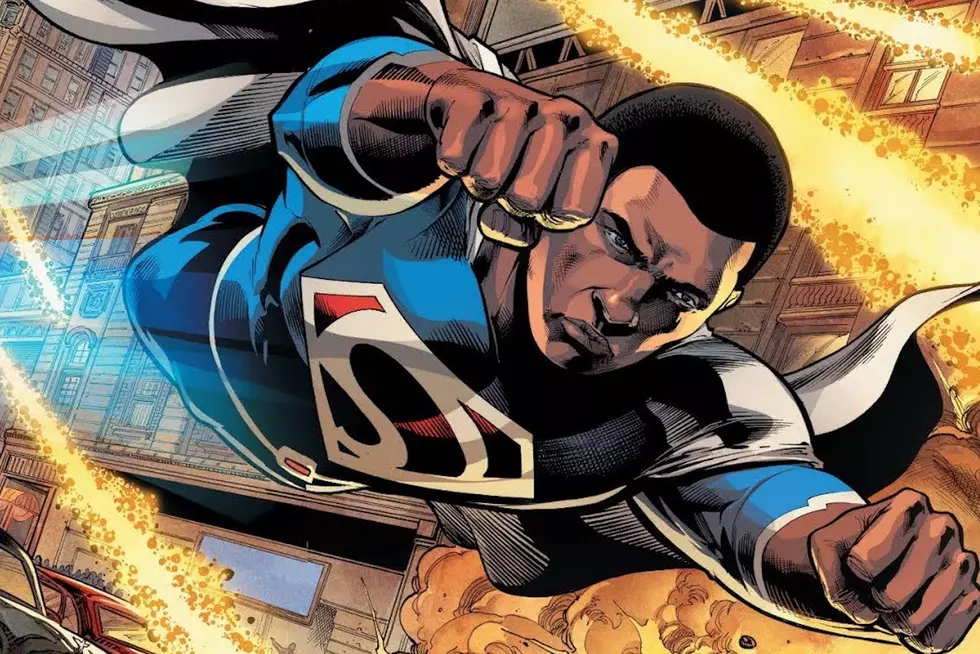
Ask Chris #248: The Zero Effect; Is Mister Freeze the Best Example of Villain Reinvention?
Q: Has there ever been a more notable or successful reinvention of a villain than the transition from Mr. Zero to Mister Freeze? -- @spacetimeboss
A: Friend, you are not kidding about Mr. Freeze. As much as heroes and villains change over the years, and as much as they have to change to stay relevant as hundreds of creators work on their ongoing stories, I honestly don't know if there's any bad guy who made a change that dramatic, both in terms of theme and quality. He goes from being a one-note crook with an ice gun to one of the most compelling and tragic figures in Batman's entire Rogues Gallery. I'd even go as far as saying that aside from Two-Face, he's the easiest of the major villains to sympathize with --- and he probably works in a whole lot more stories besides.
But while Freeze is probably the most dramatic success, he's far from the only one. The major difference is that a lot of the other villains I can think of were already pretty great --- they just got better.
Not that Dave Wood and Sheldon Moldoff's "The Ice Crimes of Mr. Zero" is a bad story, you understand. It's actually one of the better stories of the era, but it's about as much of a generic, one-note gimmick crime story as you can get, and a lot of what would eventually form the core of Mr. Freeze's character is completely absent in his predecessor. There's no tragedy, no cryogenically frozen Nora, no loss of everything he cared about that pushed him into crime, and in fact, when we find out his origin, he's already a crook who just happens to be working on building an ice gun when the whole thing blows up in his face. He even gets cured at the end of the story --- by a steam bath, no less --- bringing everything to a tidy and, if we're being honest here, ultimately forgettable closure.
On the other hand, that story also gave us Batman and Robin chasing down an ice cream truck on jet skates, so, you know.
It's probably in the top ten of all time.
As for the modern reinvention, well, it almost goes without saying at this point, but it definitely owes a lot to Batman: The Animated Series, and not just in terms of the theme. That show was very good at presenting complex villains and showing Batman himself as being sympathetic to them, and it obviously didn't hurt that millions of people had that show as their first exposure to the character. Honestly, though? I think a lot of his success came from how good Mike Mignola's redesign was.
It's streamlined and undeniably retro, but the mad scientist goggles and fishbowl helmet, which could've easily come off feeling goofy as heck, work beautifully in the context of a setting that's entirely built on '40s Art Deco. It's stripped down to suit the animated style, but it works perfectly, and there's a reason why every other version of the character seems bulky and awkward by comparison.
That said, as much as Zero-to-Freeze feels like an overnight change, and as much as it actually is, its roots go back further than you might think. Even in Freeze's first appearance on the TV show --- which I think might be the first time they changed the name --- plays with the idea that he's been left cold both physically and emotionally, a simple idea that became the core of his character. Obviously, the emotional core of it wasn't a part of that, yet --- Nora Fries wouldn't show up until the Animated Series --- but he's one of the few villains that we see actually murdering someone on the show. He freezes and shatters a cop in a scene that's downright... chilling.
Listen, I'm sorry but it was right there.
Anyway, that's enough of a shift in how Freeze was presented that it ended up being quite literally the first thing that happens in the pages of Gotham Central:
Point being, as much as it feels like a reinvention that happened overnight - and as much as you can trace it pretty directly to Paul Dini, Bruce Timm, and "Heart of Ice" --- Mr. Zero's transition into becoming Mr. Freeze was a longer and more gradual process than it might seem. And really, the same is true for a lot of villains who get notable revamps.
The biggest and most notable is probably Catwoman. She's vastly different in her first appearance than the modern version who holds down her own title as less of a supervillain and more of a Robin Hood-style thief and occasional romantic foil for Batman, but that's a process that's been going on forever. She's teaming up with Batman as early as the '50s, there's romantic tension in the '60s, and by the '70s, she's completely reformed and they're married --- on Earth-2, at least. There are themes there that are in place through multiple reboots and interpretations of the character.
If you want to talk about a reinvention that happens all at once, though, there's one that sticks out as being what might be the most drastic and successful reinvention of all time: Lex Luthor.
There's something that sets Luthor apart from Mr. Freeze, though. While Mr. Zero was created as an ultimately forgettable one-shot villain, Luthor was already Superman's arch-nemesis --- and he was already pretty great.
I've written at length before about how the Silver Age "Death of Superman" is one of my all-time favorite stories, and Luthor's role in that as a villain who preys on Superman's faith in human nature only to betray and murder him, then gleefully recount the experience to other adoring criminals makes for an amazing portrait of cruelty. But at the same time, Luthor, the brilliant scientist who idolizes Einstein and Blackbeard in equal measure, is a character who's meant for a very specific kind of comics.
I mean, really. He lives in a place called the Nefarium with an evil dog named Destructo that he gave super-powers to in order to fight Superman's pets.
That's a shade over the top.
But it works, because Superman as a character demands villains who are that far removed from everyone else. That panel above, for instance, is from one of the greatest Superman stories ever printed, where Luthor hates Superman so much that he brainwashes himself to be good, setting up a romance that will make him want to change, just so that he can get close enough to Superman to kill him, and the consequence of having to live with the knowledge that he willingly destroyed his only chance at ever being truly happy for a plain that failed like all the others. It's in Action Comics #511-513, and if you don't already have it, you should probably go ahead and get that. Terra Man's in it. It's great.
The point is, it's debatable as to whether it was strictly necessary to reinvent Lex Luthor in the '80s, but it's easy to see why they did it. He, like Jimmy Olsen, was emblematic of the kind of story that DC was trying to get away from --- except that unlike Jimmy, who was basically put in the warehouse with the Ark of the Covenant while Top Men were working on a pitch, Luthor was a little too important to the story to be ditched outright.
So if you're going to keep him, it becomes a question of how to apply those same character traits to a more realistic setting. What does an evil genius look like in the real world? If you're trying to get away from popped collars and battlesuits, what kind of power can an ordinary human being have that would be a challenge for Superman? What kind of person would be so ruthless, so amoral and so unstoppable that we'd need the most powerful person in the world to stand up to him for us?
When you're asking those questions, the answer that John Byrne, Marv Wolfman and George Perez came up with is obvious: He's a corporate CEO.
As easy as it is to make that connection in retrospect, and as much as Byrne was working on a Superman pitch at least as early as 1984, it's worth noting that it wasn't an idea that came out of nowhere. It's easy to see that there's an influence there from the Kingpin in Daredevil, for instance, if only because they're both ruthless, bald, untouchable "legitimate businessmen."
But it all works just as well as the older version Lex, because it's all rooted in the same themes, just applied to a world that's built for a slightly different approach. Superman was created as a champion of the oppressed, and rebuilding his primary antagonist as a rich and powerful businessman that Metropolis depends on economically means that he's functionally fighting the same battle against slumlords and gangsters that he was Action Comics #1, just on a superheroic scale, and casting Lex as a ruthless genius and businessman means that you can still do all those stories about green-and-purple battlesuits. The difference is that it also means that Lex can very easily get out of ever being charged for those crimes, making him an enemy that, for all his strength, Superman can't just punch.
Well, I guess he could punch him, but it's not going to get him anywhere.
It worked well enough that, like Mr. Freeze, it became the character's default state, surviving multiple Superman origin retcons more-or-less intact, and I suspect that's because of how adaptable it was to different stories. When Grant Morrison and Howard Porter brought back the Injustice Gang for the '90s JLA book, for instance, Lex was every bit as much of a charter member as he was when the Legion of Doom was hanging out in the swamp on Super Friends, but conducted himself like a businessman. The dude was even President of the United States that one time, and that's not really a story you can do with the Silver Age version, no matter how strongly I would consider voting for any candidate who referred to his home as a "Nefarium."
Obviously, Lex would eventually go back to the battlesuits and megalomaniacal plans for world domination, but the elements of his character that started with the post-Crisis reboot have been present in every version since. It makes sense, and it allows for you to do all the same stuff - including all the stuff that might otherwise feel like it's entirely a product of the Silver Age - while adding a new twist onto it that changes the context for everything. It's one of the few attempts at adding "realism" to a Superman story that made it work just as good if not better than it already was, and kept Superman's battles feeling relevant to the real world on more than just an over-the-top metaphorical level.
I mean, it's no Private Eye Riddler, but then, what is?
Ask Chris art by Erica Henderson. If you’ve got a question you’d like to see Chris tackle in a future column, just send it to @theisb on Twitter with the hashtag #AskChris.
More From ComicsAlliance









